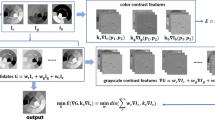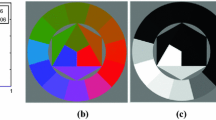Abstract
Decolorization is a fundamental technology indispensable for image processing, digital printing, and photograph rendering, while it suffers from information loss. This paper presents a novel parametric ratio-based method for efficient contrast-preserving decolorization (PrDecolor). For better preserving the details, features and visual distinctiveness of original color contrast, the proposed method simplifies and improves the current ratio-based decolorization model by incorporating the multivariate parametrical constraint. Moreover, the newly defined model is solved by efficient augmented Lagrangian and alternating direction method. The presented algorithm exhibits excellent iterative convergence and robustness with respect to the parameters. Extensive experiments under a variety of test images and a comprehensive evaluation against existing state-of-the-art methods consistently demonstrate the potential of the proposed algorithm.










Similar content being viewed by others
References
Afonso M, Bioucas-Dias J, Figueiredo M (2011) An augmented Lagrangian approach to the constrained optimization formulation of imaging inverse problems. IEEE Trans Image Process 20(3):681–695
Ancuti CO, Ancuti C, Bekaert P (2011) Enhancing by saliency guided decolorization. In: Proceedings of IEEE conference CVPR, pp 257–264
Bala R, Eschbach R (2004) Spatial color-to-grayscale transform preserving chrominance edge information. In Color Imaging Conference, pp 82–86
Cadik M (2008) Perceptual evaluation of color-to-grayscale image conversions. Comput Graph Forum 27(7):1745–1754
Cui J, Liu Y, Xu Y et al (2013) Tracking generic human motion via fusion of low-and high-dimensional approaches. IEEE Trans Syst 43(4):996–1002
Daubechies I, Defrise M, De M (2004) An iterative thresholding algorithm for linear inverse problems with a sparsity constraint. Commun Pure Appl Math 57(11):1413–1457
Du H, He S, Sheng B, Ma L, Lau R (2015) Saliency-guided color-to-gray conversion using region-based optimization. Image processing. IEEE Trans Image Process 24(1):434–443
Gooch A, Olsen SC, Tumblin J, Gooch B (2005) Color2gray: salience-preserving color removal. ACM Trans Graph 24(3):634–639
Gorodnitsky I, Rao B (1997) Sparse signal reconstruction from limited data using FOCUSS: a re-weighted minimum norm algorithm. IEEE Trans Signal Process 45(3):600–616
Grundland M, Dodgson NA (2007) Decolorize: fast, contrast enhancing, color to grayscale conversion. Pattern Recogn 40(11):2891–2896
He J, Liu Q, Christodoulou AG, Ma C, Lam F, Liang Z-P (2016) Accelerated high-dimensional MR imaging with sparse sampling using low-rank tensors. IEEE Trans Med Imag 32(7):2119–2129
Jin Z, Ng M (2015) A contrast maximization method for color-to-grayscale conversion. Multidim Syst Sign Process 26(3):869–877
Jin Z, Li F, Ng M (2014) A variational approach for image decolorization by variance maximization. SIAM J Imag Sci 7(2):944–968
Kim Y, Jang C, Demouth J, Lee S (2009) Robust color-to-gray via nonlinear global mapping. ACM Trans Graph 28(5):1–4
Kuk J, Ahn J, Cho N (2010) A color to grayscale conversion considering local and global contrast. 10th Asian Conference on Computer Vision, Queenstown, pp 513–524
Liu Y, Zhang X, Cui J et al (2010) Visual analysis of child-adult interactive behaviors in video sequence. Virtual Systems and Multimedia (VSMM), 2010 16th International Conference on, pp 26–33
Liu Q, Wang S, Luo J, Zhu Y, Ye M (2012) An augmented Lagrangian approach to general dictionary learning for image denoising. J Vis Commun Image Represent 23(5):753–766
Liu Y, Cui J, Zhao H et al (2012) Fusion of low-and high-dimensional approaches by trackers sampling for generic human motion tracking. Pattern Recognition (ICPR), 2012 21st International Conference on, pp 898–901
Liu Q, Liang D, Song Y, Luo J, Zhu Y, Li W (2013) Augmented Lagrangian based sparse representation method with dictionary updating for image deblurring. SIAM J Imag Sci 6(3):1689–1718
Liu Q, Liu J, Dong P, Liang D (2013) SGTD: Structure gradient and texture decorrelating regularization for image decomposition. In Proceedings of the IEEE International Conference on Computer Vision, Sydney, pp 1081–1088
Liu Q, Peng X, Liu J, Yang D, Liang D (2014) A weighted two-level bregman method with dictionary updating for nonconvex MR image reconstruction. J Biomed Imaging 11:128596–128596
Liu Q, Liu Peter X, Xie W, Wang Y, Liang D (2015) GcsDecolor: gradient correlation similarity for efficient contrast preserving decolorization. IEEE Trans Image Process 23(5):2889–2904
Liu Q, Liu X, Wang Y, Leung H (2016) Semi-parametric decolorization with laplacian-based perceptual quality metric. IEEE Trans Circuits Syst Video Technol 99:1–13
Liu Y, Nie L, Liu L et al (2016) From action to activity: sensor-based activity recognition. Neurocomputing 181:108–115
Lu C, Xu L, Jia J (2012) Contrast preserving decolorization. In: IEEE international conference on computational photography (ICCP), pp.1-7
Lu C, Xu L, Jia J (2014) Contrast preserving decolorization with perception-based quality metrics. Int J Comput Vis 110(2):222–239
Lu Y, Wei Y, Liu L et al (2017) Towards unsupervised physical activity recognition using smartphone accelerometers. Multimedia Tools and Applications 76(8):10701–10719
Neumann L, Cadik M, Nemcsics A (2007) An efficient perception-based adaptive color to gray transformation. In: Computational aesthetics, pp 73–80
Osher S, Burger M, Goldfarb D, Xu J, Yin W (2005) An iterative regularization method for total variation-based image restoration. Multiscale Model Simul 4(2):460–489
Rao B, Kreutz-Delgado K (1999) An affine scaling methodology for best basis selection. IEEE Trans Signal Process 47(1):187–200
Rasche K, Geist R, Westall J (2005) Re-coloring images for gamuts of lower dimension. Comput Graph Forum 24(3):423–432
Rockafellar R (1976) Augmented Lagrangians and applications of the proximal point algorithm in convex programming. Math Oper Res 1(2):97-116
Rodriguez P, Wohlberg B (2008) An efficient algorithm for sparse representations with l p data fidelity term. Proceedings of 4th IEEE Andean Technical Conference (ANDESCON)
Smith K, Landes PE, Thollot J, Myszkowski K (2008) Apparent greyscale: a simple and fast conversion to perceptually accurate images and video. Comput Graph Forum 27(2):193–200
Song M, Tao D, Chen C, Li X, Chen CW (2010) Color to gray: visual cue preservation. IEEE Trans Pattern Anal Mach Intell 32(9):1537–1552
Song Y, Bao L, Xu X, Yang, Q (2013) Decolorization: Is rgb2gray () out?. In SIGGRAPH Asia 2013 Technical Briefs, Hong Kong, p 15
Song M, Tao D, Bu J, Chen C, Yang Y (2013a) Color-to-gray based on chance of happening preservation. Neurocomputing 119:222–231
Xie X, Zaitsev Y, Velásquez-García LF et al (2014) Scalable, MEMS-enabled, vibrational tactile actuators for high resolution tactile displays. J Micromech Microeng 24(12):125014
Xie X, Zaitsev Y, Velasquez-Garcia L, Teller S, Livermore C (2014) Compact, scalable, high-resolution, MEMS-enabled tactile displays. In Proc. of Solid-State Sensors, Actuators, and Microsystems Workshop, pp 127–130
Yang J, Zhang Y (2011) Alternating direction algorithms for l 1 -problems in compressive sensing. SIAM J Sci Comput 33(1):250–278
Yang J, Zhang Y, Yin W (2009) An efficient TV l 1 algorithm for deblurring multichannel images corrupted by impulsive noise. SIAM J Sci Comput 31(4):2842–2865
Yin W, Osher S, Goldfarb D, Darbon J (2008) Bregman iterative algorithms for l 1 -min 168 imization with applications to compressed sensing. SIAM J Imag Sci 1(1):143
Author information
Authors and Affiliations
Corresponding author
Additional information
Project supported by the National Natural Science Foundation of China under 61661031, 61362001, 61503176, Jiangxi Advanced Projects for Post-doctoral Research Funds (2014KY02)
Appendix
Appendix
In earlier literatures [11] and [19], we found that the AL and ADM have been applied to solve the low-rank factorization based matrix separation problem and dictionary learning problem. For these non-convex problems they both provided a weak convergence result for their algorithm, i.e. under mild conditions any limit point of the iteration sequence generated by the algorithm is a KKT point. In our work, for this new non-convex problem we also give a similar result with regard to the convergence of the algorithm PrDecolor. It should be emphasized that although the following convergence result far from being satisfactory, it provides an assurance for the behavior of the algorithm.
Since the sub-gradient of the L(w, s) are as follows:
Additionally, by considering the constraints \( {s}_{x,y}=\sum_{I_l\in {Z}_2}{w}_l\nabla {I}_l \), it is straightforward to obtain the KKT conditions for (5) are as follows:
Proposition 1
Let X ≜ (w, s) and \( {\left\{{X}^k\right\}}_{k=1}^{\infty } \) be generated by our algorithm PrDecolor, Assume that \( {\left\{{X}^k\right\}}_{k=1}^{\infty } \) is bounded and \( \underset{k\to \infty }{\lim}\left({X}^{k+1}-{X}^k\right)=0 \). Then any accumulation of \( {\left\{{X}^k\right\}}_{k=1}^{\infty } \) satisfies the KKT conditions (16). In particular, whenever \( {\left\{{X}^k\right\}}_{k=1}^{\infty } \) converges, it converges to a KKT point of (5).
Proof
Firstly, since \( {w}^{k+1}=\frac{\sum_{I_l\in {Z}_2}\nabla {I_l}^T\left({s}_i^{k+1}-{\lambda}^{k+1}/\gamma \right)}{\sum_{I_l\in {Z}_2}\nabla {I_l}^T\nabla {I}_l} \), it follows that
Secondly,
Finally, it follows that
Hence \( \underset{k\to \infty }{\lim}\left({X}^{k+1}-{X}^k\right)=0 \) implies that both sides of (17)(18)(19) all tend to zero as k goes to infinity. Consequently,
where the first limit in (20) is used to derive other limits. That is, the sequence \( {\left\{{X}^k\right\}}_{k=1}^{\infty } \) asymptotically satisfies the KKT conditions (16), from which the conclusions of the proposition follow readily. This completes the proof.
Rights and permissions
About this article
Cite this article
Xiong, J., Lu, H., Liu, Q. et al. Parametric ratio-based method for efficient contrast-preserving decolorization. Multimed Tools Appl 77, 15721–15745 (2018). https://doi.org/10.1007/s11042-017-5143-6
Received:
Revised:
Accepted:
Published:
Issue Date:
DOI: https://doi.org/10.1007/s11042-017-5143-6




